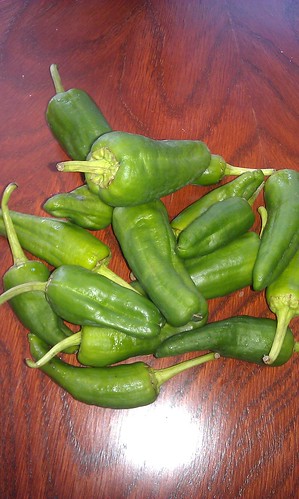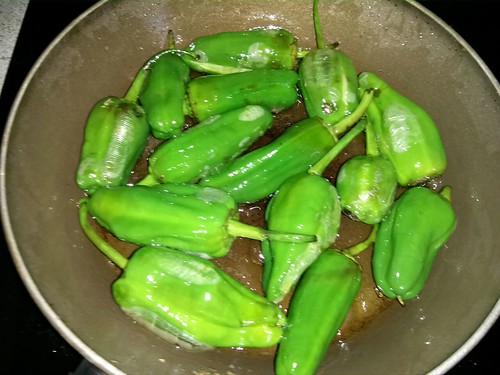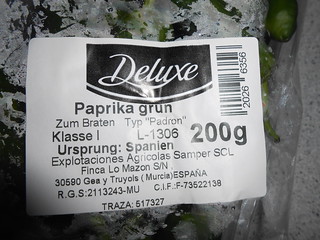Glossary P
Pimientos de Padron is also simply known as Padron, a variety of non-spicy pepper which originated from Padron, Galicia, Spain. In Spain, they are often serve as Tapa.
Padron is called Bratpaprika or Paprika grun in Germany.
Brat is translated as fry, roast or grill. Bratpaprika literally means "frying pepper", pepper intented for frying grilling or roasting and served as a side dish.
I love Padron very much. Whenever they are available in the supermarkets, I buy some packs and sautee them in olive oil and a bit of salt, sometimes I put a little amount of soy sauce and it taste good, too.
Below are pictures of fresh Padron and my sauteed Padron.

Padron being sauteed in Olive Oil and Soysauce, below with a dash of lemon juice, my own invention

This Padron travelled all the way from Spain to Germany.

Deutsch: Pinagong / Español: Pinagong / Português: Pinagong / Français: Pinagong / Italiano: Pinagong
Pinagong is a traditional Filipino bread known for its distinct turtle shell-like pattern on top, which is where it gets its name – "pagong" meaning turtle in Tagalog. This bread is a type of hard bread with a slightly sweet taste and a dense, chewy texture. It is typically enjoyed as a snack or breakfast item, often paired with coffee or hot chocolate.
Deutsch: Pinais na Isda / Español: Pinais na Isda / Português: Pinais na Isda / Français: Pinais na Isda / Italiano: Pinais na Isda
Pinais na Isda is a traditional Filipino dish that involves wrapping fish or shrimp in banana leaves with a mixture of coconut milk, garlic, ginger, and sometimes other ingredients like tomatoes or chili peppers. The wrapped fish is then steamed or grilled, allowing the flavors to infuse into the seafood while keeping it moist and tender. This cooking method not only imparts a distinct aroma and flavor but also preserves the fish, a technique deeply rooted in Filipino culinary tradition.
Pinakurat refers to a variety of vinegar from the Philippines made from fermented coconut sap which is known in the Philippines as Tuba and bird’s eye chilies called Kulikot (Siling Labuyo). Pinakurat is used as a dipping sauce for various grillled and fried foods and as an ingredient for dishes cooked with vinegar, like Kinilaw (ceviche).
Suka Pinakurat is said to have originated from the Mindanao Island of the Philippines, and its is named after a spicy dish from the same region.
Personal Note: I have remembered this variety of Suka from my home country during my research about the food of the Philippines. I know one way or the other I have tasted it somewhere in Mindanao while I acted as a Census Supervisor, but it is a pity that I tasted it many years ago, but didn't find the time to know just what it is all about until now that I do research about worldwide food. I know right away that I have to add it to my Glossary of wordwide food. It is nice to know that there are such nice products from the Philippines which we can be proud of and I thank the creative Filipinos who invent and concoct something delicious for the other countries to enjoy.
English: Pounded / Deutsch: Gehackt / Español: Triturado / Português: Socado / Français: Pilé / Italiano: Pestato /
Pinaltok refers one of the sweet food from the Philippines which is served as snacks made from ground glutinous rice shaped like little balls and Sago (Sago pearls, that is) cooked in Coconut Milk. These glutinous rice balls are called Bilo-Bilo, hence Pinaltok is simply called Bilo-Bilo or Ginataang Bilo-Bilo in other Tagalog regions of the country.
Pinamalhan is a dish from the Philippines, the Ilonggo version of Paksiw (fish cooked in Vinegar). Pinamalhan is an Ilonggo method of preparing fish by cooking it in vinegar, soy sauce, ginger, garlic and a host of other spices and seasoning. It is actually a Paksiw but a dry version.
Pinamalhan is made by putting all ingredients in the pan and cook until dry.
Pinamalhan is from the Ilonggo word "mala" meaning dry, hence its name.
